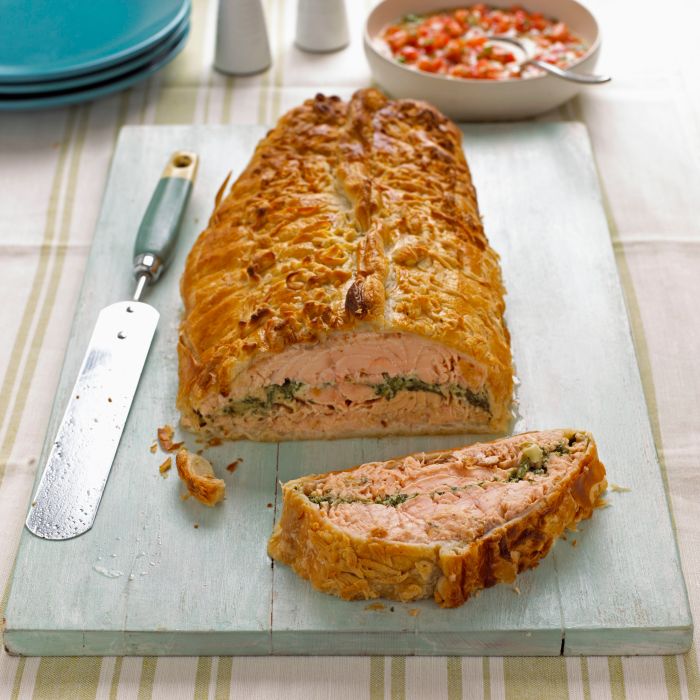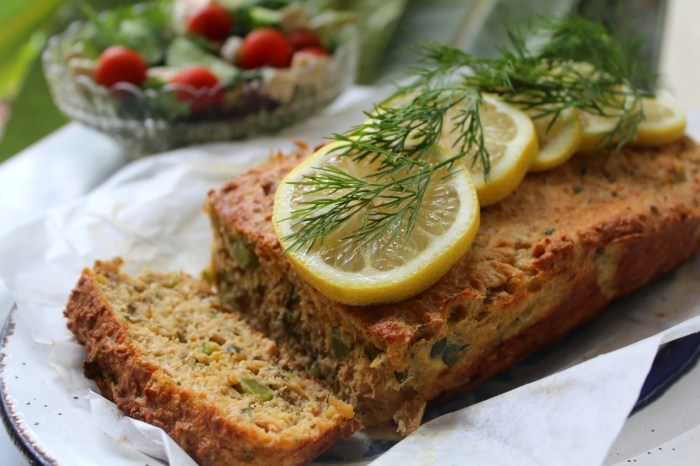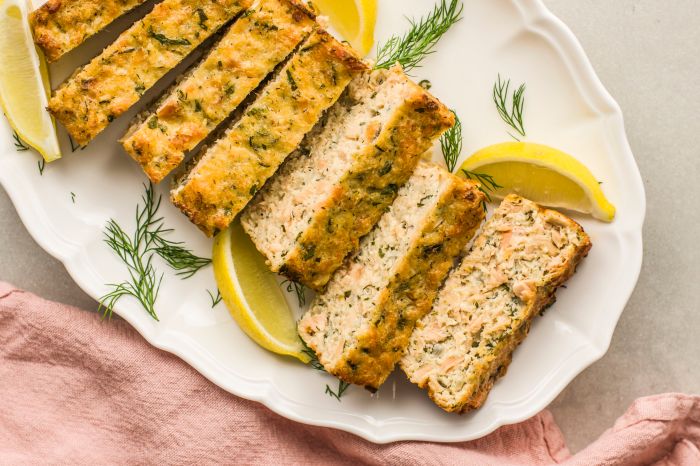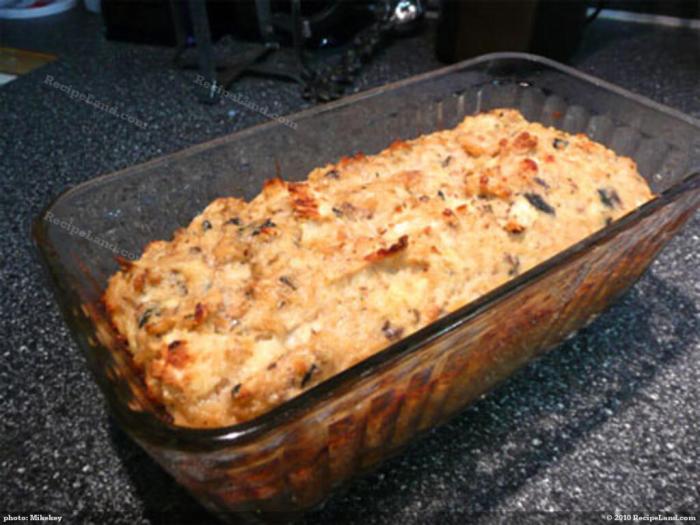Salmon loaf recipe is a beloved dish that combines the delicate flavor of salmon with the hearty texture of a loaf. This versatile recipe has been enjoyed for generations, evolving into a culinary staple that satisfies both taste buds and dietary needs.
The origins of salmon loaf can be traced back to a time when resourceful cooks sought ways to utilize leftover salmon. The dish gained popularity in the early 20th century, appearing in cookbooks and magazines. Today, salmon loaf remains a comforting and flavorful option for home cooks and chefs alike.
Salmon Loaf: A History and Overview

Salmon loaf is a versatile and flavorful dish that has been enjoyed for generations. It is a savory loaf made with ground salmon, typically mixed with bread crumbs, eggs, and seasonings, and baked until golden brown. Salmon loaf is a popular choice for a quick and easy weeknight meal or a more elegant presentation for a special occasion.
The Origins of Salmon Loaf
Salmon loaf has a long and interesting history, with its origins rooted in the need to use up leftover salmon. In the early days of commercial fishing, salmon was often a plentiful and inexpensive ingredient, but it could spoil quickly.
As a result, cooks devised ways to preserve the fish, such as canning, smoking, or making salmon loaf. The earliest known recipes for salmon loaf date back to the 19th century, and the dish quickly gained popularity in the United States and Canada.
Interesting Facts about Salmon Loaf
Salmon loaf is a versatile dish that can be customized to suit different tastes and preferences. Here are a few interesting facts about salmon loaf:
- Salmon loaf can be made with different types of salmon, including sockeye, king, and pink salmon.
- The addition of vegetables, such as chopped celery, onion, or carrots, can add flavor and texture to the loaf.
- Salmon loaf can be served hot or cold, and it can be enjoyed as a main course, a side dish, or even a sandwich filling.
- Salmon loaf is a good source of protein, omega-3 fatty acids, and other essential nutrients.
Ingredients

Salmon loaf is a versatile dish that can be adapted to suit different dietary needs and preferences. The core ingredients, however, remain largely consistent. The basic salmon loaf recipe typically includes canned salmon, eggs, breadcrumbs, and seasonings. These ingredients provide the foundation for a flavorful and moist loaf.
Ingredient Variations and Substitutions
Variations and substitutions in salmon loaf recipes often cater to dietary restrictions or personal preferences. For example, individuals following a gluten-free diet can replace breadcrumbs with almond flour or crushed crackers. Those seeking a lower-fat option may substitute Greek yogurt or cottage cheese for the eggs.
Furthermore, individuals with egg allergies can utilize flaxseed meal or applesauce as egg substitutes.
Nutritional Information
The nutritional value of salmon loaf varies depending on the specific ingredients used. However, a typical salmon loaf is a good source of protein, omega-3 fatty acids, and vitamins. The following table provides a general overview of the nutritional information of common salmon loaf ingredients:| Ingredient | Calories (per 100g) | Protein (per 100g) | Fat (per 100g) | Carbohydrates (per 100g) ||—|—|—|—|—|| Canned Salmon | 120 | 20 | 5 | 0 || Eggs | 155 | 13 | 11 | 1 || Breadcrumbs | 350 | 9 | 2 | 75 || Milk | 50 | 3 | 3 | 5 || Onion | 40 | 1 | 0 | 9 || Parsley | 30 | 3 | 0 | 7 |
Note:The nutritional information provided is approximate and may vary depending on the brand and type of ingredients used.
Preparation Methods

Preparing a salmon loaf is a straightforward process that involves combining cooked salmon with other ingredients, shaping the mixture into a loaf, and baking it until cooked through. This process can be adapted to suit various preferences, with different cooking methods and ingredients adding their unique flavor and texture to the final dish.
Baking
Baking is the most common method for preparing salmon loaf. It involves spreading the salmon mixture into a loaf pan and baking it in a preheated oven until it’s cooked through and slightly browned on top. Baking ensures even cooking and allows for the development of a crispy crust.
- Preheat the oven to 350°F (175°C). Grease a loaf pan with butter or cooking spray.
- Combine the cooked salmon with the remaining ingredients, ensuring they are well mixed.
- Transfer the mixture to the prepared loaf pan and spread it evenly.
- Bake for 30-40 minutes, or until a toothpick inserted into the center comes out clean.
- Let the loaf cool slightly before slicing and serving.
Steaming
Steaming is a healthier alternative to baking, as it requires no added oil and retains the moisture of the salmon. It involves placing the salmon mixture in a steamer basket and steaming it until cooked through. Steaming produces a tender and moist salmon loaf.
- Fill a steamer pot with water and bring it to a boil.
- Place the salmon mixture in a steamer basket and secure it over the boiling water.
- Steam for 20-25 minutes, or until a toothpick inserted into the center comes out clean.
- Let the loaf cool slightly before slicing and serving.
Grilling
Grilling is a quick and flavorful method for preparing salmon loaf. It involves shaping the mixture into a loaf and grilling it over medium heat until cooked through and slightly charred. Grilling imparts a smoky flavor to the loaf.
- Preheat a grill to medium heat.
- Shape the salmon mixture into a loaf and wrap it in aluminum foil.
- Place the foil-wrapped loaf on the grill and cook for 15-20 minutes, or until a toothpick inserted into the center comes out clean.
- Unwrap the loaf and grill for an additional 5-10 minutes to achieve a slightly charred crust.
- Let the loaf cool slightly before slicing and serving.
Different Preparation Methods
| Method | Description | Pros | Cons |
|---|---|---|---|
| Baking | Spreading the salmon mixture into a loaf pan and baking in a preheated oven. | Even cooking, crispy crust, versatile. | May require additional time and energy. |
| Steaming | Placing the salmon mixture in a steamer basket and steaming until cooked through. | Healthy, retains moisture, tender texture. | May require specialized equipment. |
| Grilling | Grilling the salmon mixture over medium heat until cooked through. | Quick cooking, smoky flavor, char marks. | May require careful monitoring to prevent burning. |
Flavor Variations

The beauty of salmon loaf lies in its adaptability. You can easily customize its flavor profile to suit your preferences and create a truly unique dish. By incorporating different herbs, spices, and sauces, you can explore a world of taste sensations.
Flavor Profiles
Here are a few recipes for different salmon loaf flavor profiles:
Lemon Dill
- 1 pound salmon, skin and bones removed
- 1/2 cup mayonnaise
- 1/4 cup chopped fresh dill
- 1 tablespoon lemon juice
- 1 teaspoon grated lemon zest
- 1/2 teaspoon salt
- 1/4 teaspoon black pepper
Combine all ingredients in a bowl and mix until well combined. Transfer to a loaf pan and bake at 350°F for 20-25 minutes.
Garlic Herb
- 1 pound salmon, skin and bones removed
- 1/2 cup mayonnaise
- 1/4 cup chopped fresh parsley
- 2 tablespoons chopped fresh chives
- 2 cloves garlic, minced
- 1 teaspoon dried oregano
- 1/2 teaspoon salt
- 1/4 teaspoon black pepper
Combine all ingredients in a bowl and mix until well combined. Transfer to a loaf pan and bake at 350°F for 20-25 minutes.
Spicy
- 1 pound salmon, skin and bones removed
- 1/2 cup mayonnaise
- 1 tablespoon sriracha sauce
- 1 teaspoon grated ginger
- 1/2 teaspoon garlic powder
- 1/4 teaspoon cayenne pepper
- 1/4 teaspoon salt
- 1/4 teaspoon black pepper
Combine all ingredients in a bowl and mix until well combined. Transfer to a loaf pan and bake at 350°F for 20-25 minutes.
Incorporating Additional Flavors
To enhance the flavor of your salmon loaf, consider adding:
Herbs and Spices
- Fresh herbs:Dill, parsley, chives, tarragon, basil, cilantro
- Dried herbs:Oregano, thyme, rosemary, sage
- Spices:Garlic powder, onion powder, paprika, cumin, chili powder
Sauces
- Creamy sauces:Sour cream, crème fraîche, Greek yogurt
- Tangy sauces:Lemon juice, lime juice, Dijon mustard
- Spicy sauces:Sriracha sauce, hot sauce, chili paste
Creating a Visually Appealing and Flavorful Salmon Loaf
To make your salmon loaf visually appealing and flavorful:
- Use high-quality salmon:Opt for fresh, wild-caught salmon for the best flavor and texture.
- Add a colorful garnish:Top the loaf with fresh herbs, lemon slices, or a sprinkle of paprika for a vibrant presentation.
- Serve with a side dish:Pair your salmon loaf with a simple salad, roasted vegetables, or a creamy sauce to enhance the overall dining experience.
Serving Suggestions: Salmon Loaf Recipe
Salmon loaf is a versatile dish that can be enjoyed in a variety of ways. Whether you prefer a classic presentation or something more creative, there are endless possibilities for serving this flavorful and satisfying dish.The rich, savory flavors of salmon loaf pair well with a range of side dishes and accompaniments.
Find out about how soup recipes abiotic factor can deliver the best answers for your issues.
Consider the textures and flavors that complement the salmon loaf to create a well-balanced meal.
Side Dish Ideas, Salmon loaf recipe
The following side dishes can enhance the flavors and textures of salmon loaf:
- Classic accompaniments: Potato salad, coleslaw, green beans, or a simple side of rice are classic options that provide a satisfying balance to the salmon loaf.
- Roasted vegetables: Roasted vegetables like asparagus, broccoli, or Brussels sprouts add a touch of sweetness and earthiness to the meal.
- Salads: A light and refreshing salad with a vinaigrette dressing can cut through the richness of the salmon loaf. Consider a simple green salad, a fruit salad, or a mixed green salad with a variety of vegetables.
- Grain bowls: Combine the salmon loaf with quinoa, couscous, or farro for a hearty and healthy meal.
Accompaniments and Sauces
Accompaniments and sauces can elevate the flavor profile of salmon loaf:
- Lemon wedges: A squeeze of lemon juice brightens the flavors of the salmon loaf and adds a refreshing touch.
- Dill sauce: A creamy dill sauce complements the salmon flavor and adds a touch of freshness.
- Hollandaise sauce: This classic sauce adds a rich and buttery flavor to the salmon loaf.
- Tartar sauce: A tangy tartar sauce provides a contrasting flavor to the salmon loaf.
- Mustard sauce: A mustard sauce adds a spicy kick to the salmon loaf.
Plating Ideas
| Plating Style | Description | Example ||—|—|—|| Classic| Serve the salmon loaf on a platter with a side of mashed potatoes, green beans, and a lemon wedge. | || Modern| Slice the salmon loaf and arrange it on a plate with a bed of quinoa and roasted vegetables.
Drizzle with a lemon-herb vinaigrette. | || Rustic| Serve the salmon loaf on a bed of mixed greens with a drizzle of olive oil and balsamic vinegar. | || Elegant| Slice the salmon loaf and arrange it on a bed of arugula with a dollop of dill sauce and a sprinkle of fresh dill.
| |
Storage and Leftovers
Salmon loaf, with its rich flavor and versatility, is a dish that often yields leftovers. Properly storing and repurposing these leftovers can help you maximize your culinary efforts and enjoy the deliciousness of this dish in various ways.
Storing Leftover Salmon Loaf
Refrigerating leftover salmon loaf is the best way to preserve its freshness and quality. It’s crucial to store it correctly to prevent spoilage and maintain its flavor. Here’s how to store leftover salmon loaf:
- Store in an airtight container: An airtight container prevents the salmon loaf from drying out and absorbing other flavors in your refrigerator.
- Refrigerate promptly: Place the leftover salmon loaf in the refrigerator as soon as it has cooled down to room temperature. This helps to slow down the growth of bacteria.
- Refrigerate for up to 3-4 days: Leftover salmon loaf can typically be stored in the refrigerator for 3-4 days. However, it’s best to consume it within this timeframe to ensure the best flavor and texture.
Repurposing Leftover Salmon Loaf
Leftover salmon loaf can be transformed into a variety of new dishes, adding a burst of flavor and protein to your meals. Here are some creative ideas for repurposing leftover salmon loaf:
- Salmon loaf salad: Flake the leftover salmon loaf and toss it with your favorite salad greens, vegetables, and a light dressing. The combination of flavors and textures will make for a refreshing and satisfying meal.
- Salmon loaf sandwiches: Slice the leftover salmon loaf and use it as a filling for sandwiches. Add your favorite toppings like lettuce, tomato, onion, and cheese for a flavorful and protein-packed lunch or snack.
- Salmon loaf pasta: Dice the leftover salmon loaf and add it to your favorite pasta dish. The salmon loaf will add a rich, savory flavor to the pasta, creating a hearty and satisfying meal.
- Salmon loaf frittata: Combine leftover salmon loaf with eggs, vegetables, and cheese to create a delicious and protein-packed frittata. This dish is perfect for breakfast, brunch, or a light dinner.
Freezing Salmon Loaf
Freezing salmon loaf is a great way to extend its shelf life and have it readily available for future meals. Here’s how to freeze salmon loaf:
- Wrap tightly: Wrap the salmon loaf tightly in plastic wrap or aluminum foil, ensuring no air pockets remain. This helps to prevent freezer burn and maintain the quality of the salmon loaf.
- Store in a freezer-safe bag: Place the wrapped salmon loaf in a freezer-safe bag, squeezing out any excess air. This will help to prevent freezer burn and maintain the flavor and texture of the salmon loaf.
- Freeze for up to 3 months: Frozen salmon loaf can typically be stored in the freezer for up to 3 months. However, the quality may deteriorate after this time.
Thawing Salmon Loaf
When you’re ready to use frozen salmon loaf, it’s important to thaw it properly to maintain its quality and texture. Here’s how to thaw frozen salmon loaf:
- Thaw in the refrigerator: The safest and most recommended way to thaw frozen salmon loaf is to transfer it from the freezer to the refrigerator. Allow it to thaw overnight, ensuring it’s completely thawed before using.
- Thaw in cold water: You can also thaw frozen salmon loaf in cold water. Place the sealed package of salmon loaf in a bowl of cold water, changing the water every 30 minutes to ensure it remains cold. This method can take several hours, depending on the size of the salmon loaf.
- Do not thaw at room temperature: Thawing salmon loaf at room temperature can promote bacterial growth and compromise its safety. It’s crucial to avoid this method.
Final Conclusion
From its humble beginnings to its modern-day iterations, salmon loaf continues to delight palates with its savory flavors and satisfying texture. Whether enjoyed as a main course, a lunchbox staple, or a creative appetizer, salmon loaf offers a culinary journey that is both comforting and adaptable.
